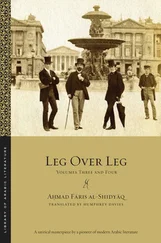
One can see this comparative tendency in the title page of Leg over Leg . As its subtitle announces (“Days, Months, and Years spent in Critical Examination of the Arabs and their Non-Arab Peers”), the narrative takes the outward form of a travelogue that follows the Fāriyāq between Europe and the Arab Middle East. In his “critical examination,” he looks outward at a cultural other, but he also reflects inwardly upon his own social background, leaving no society safe from his satirizing gaze. It takes place on the road between cultures; though influenced by Laurence Sterne and François Rabelais, it takes equal interest in the wandering scholars of the classical Arabic tradition, such as Badīʿ al-Zamān al-Hamadhānī (d. 398/1008), who — like the Fāriyāq — traveled in search of literary patronage. Though nominally Christian at the time of its publication (he added “Aḥmad” several years later), he invokes Islamic motifs and values that seem to identify him ambivalently as already Muslim. 59And though avowedly a work devoted to linguistic preservation — and indeed taking antiquarian delight in stringing together lists of rare words and in lampooning authors and orators for using incorrect language — he also claims to eschew the dominant rhetorical tendencies of the preceding centuries that produced texts “marinated in the spices of paronomasia and morphological parallelism, of metaphor and metonymy” (1.1.11).
This final contradiction helps to describe the work’s complex prose style. Leg over Leg contains many elaborate displays of linguistic erudition — in the form of its lists of synonyms but also his repeated demonstrations of rhetorical and generic mastery. Al-Shidyāq intersperses his narrative with original verse compositions and sections in rhymed prose ( sajʿ ), as well as the four maqāmāt he includes, along with other more occasional usages. These passages, combined with his quotations and intertextual references to poets and linguistic scholars, give the reader a full sense of his scholarly abilities and qualifications — he makes clear that he could hold his own with the literary masters of his time. In this sense, we can see Leg over Leg as “a last glance at a fading language,” in which the author is conscious of “the precarious state written classical Arabic reached under the growing impact of European languages and local attempts at reforming the Arab language in the Ottoman world.” 60One cannot help but wonder, however, if this final glance did not contain a glint of irony. In the opening pages, as the reader will see, he preserves classical erudition by recalling over 250 synonyms and euphemisms for “penis,” “vagina,” and “sexual intercourse.” He may have aimed to unseat literary authority even as he claimed it for himself.
In other sections, he renders events in clear and direct language that can approach the style of present-day Arabic novels. He even, on rare occasions, writes in colloquial Arabic — an act that remains controversial even today. For many scholars, the shifting of registers between formal and informal Arabic and between ornate and simple styles, marks Leg over Leg as a text produced during the transition to modernity and is one of the sources of the notorious difficulty in categorizing the work. While its title seems to present it as a travelogue, and its story follows the author’s real-life travels, its characters and events are abstracted and stylized, with rhetorical acrobatics often seeming to take precedence over attempts at ethnographic verisimilitude. Long philosophical and literary digressions frequently interrupt the plot, so that the narrative often takes on the form of a miscellany. As the narrator admits, “I committed myself to writing a book that would be a repository for every idea that appealed to me, relevant or irrelevant, for it seemed to me that what was irrelevant to me might be relevant to someone else, and vice versa” (1.10.6).
Despite this hint at formlessness, the author’s preface gives two possible generic possibilities: to “give prominence to the oddities of the language, including its rare words” (0.2.1) and to “discuss the praiseworthy and blameworthy qualities of women” (0.2.12). Yet no study exists that treats the work as either a linguistic treatise or a sociology of gender. Instead, scholars have categorized it as belonging to a variety of literary genres. Luwīs ʿAwaḍ and Shawqī Ḍayf, for example, classify it as a maqāmah or neo- maqāmah , Radwa ʿAshour as a novel (“the first and most important Arabic novel”), Matityahu Peled as Menippean, and Paul Starkey as fictional autobiography or a “voyage of self-definition.” 61For Nadia Al-Bagdadi, the work transcends categorization: she argues that it should be understood both as a novel and as “a unique literary expression of its time,” or “a genre of its own.” 62Al-Shidyāq might have agreed with this characterization. As he warns in his prefatory poem, his art is “an orphan” and “unique”; “so be well disposed toward it,” he begs his reader (0.4.5). In this verse description (and anticipatory list of complaints) of Leg over Leg , he identifies what might be the central difficulty in characterizing it: it appears as if he “pieced it together and cobbled it up by hand” (0.4.2). It might not be categorizable because it is pieced together from many genres and literary modes, as it contains passages in verse ( madīḥ, hijāʾ, ghazal, rithāʾ ), prose (with passages that imitate or make reference to historical writing, sermons, aphorisms, ethnographic writing, linguistic studies, and philosophical critiques), and prosody (it includes four original maqāmāt , as well as other passages written in rhyming prose, or sajʿ ). Alongside these Arabic exemplars, he includes sections translated from European authors, such as the travel narratives of Chateaubriand and Lamartine, and original passages written in “the Frankish way” (1.7.5). And he intersperses in these lists (many quoted, as Humphrey Davies notes in his Afterword, from Al-Qāmūs ), anecdotes, and typographical jokes which punctuate the text.
In cobbling together this multigeneric work, he renders no mode privileged over any other. Instead, he incorporates all into his narrative archive, to praise and discredit equally. As a result, there is no stable position of narrative authority in Leg over Leg , a fact perhaps announced by the work’s title itself. In a text abounding in sexual puns and innuendos, “leg over leg” could refer to an intimate union of limbs or the detached posture of an armchair academic. Moreover, this single phrase signals the linguistic and structural play built into all aspects of the work: “ al-sāq ʿalā l-sāq ” also appears within the text in a list of the conventional topoi of courtship narratives, which interrupts the very courtship story that the narrator is trying to tell:
It is the custom of my fellow writers sometimes to go back and leap over a period of time and connect an event that happened before it to an event that happened after it. This is called analepsis ( tawriyah ), that is, “taking backward ( warāʾ ).” They also may start by mentioning everything about the protagonist, from his first whisperings into his beloved’s ear until his reappearance as a married man. In the course of this, the author will relate such long and tedious matters as how his face paled and his pulse raced when he met her, how he was reduced to a tizzy and felt ill while he waited for her answer, how he sent her an old woman or a missive, how he met with her at such and such a time and place, and how she changed color when he spoke to her of the bed, of drawing her close, of embracing, of leg over leg , of kissing, of kissing tongue to tongue, of intercourse, and the like. (3.4.1)
Читать дальше













